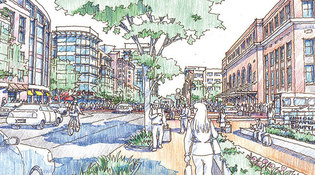 loading
loading
New HavenRethinking the city’s front doorDemolition is planned for a site across from the train station.  City of New HavenNew Haven’s Hill-to-Downtown Plan proposes new mixed-income, mixed-use development (at left in illustration above) opposite Union Station (right). View full imageFor visitors to New Haven who are exiting Union Station, the run-down Church Street South apartment complex across the street doesn’t offer much of a welcome. “It says, ‘Don’t come over here,’” says Karyn Gilvarg ’75MArch, executive director of the City Plan Department. “We want it to say, ‘Here’s a vibrant, safe, attractive city.’” New Haven now has a chance for something better, even though the chance was hastened by a crisis. The 300-unit complex had spiraled into such a state of disrepair that tenants—sick of it, and sick from it—staged a legal revolt last fall, prompting the city to condemn the property. Its residents, many suffering from the health effects of persistent black mold, have been scattered. In order to replace the complex, the city is working with two entities that critics say were part of the problem: the Department of Housing and Urban Development (HUD), which subsidizes the rents and gave the complex passing grades; and the landowner, Northland Investment Properties, a company more accustomed to high-end development. New Haven has long seen the land as a potential gateway to downtown and Yale. In 1910, Frederick Law Olmsted Jr. and the architect Cass Gilbert envisioned a Paris-style boulevard connecting the station and the New Haven Green. But it was never built. Decades later, Richard Lee—mayor during the city’s much-criticized urban renewal of the ’50s and ’60s—wanted to rid the area in front of Union Station of a longstanding produce market. By the late 1960s, amid the turbulent civil rights movement, the city opted for low-income housing. School of Architecture dean Charles Moore designed the complex, which opened in 1969. “Church Street South was somewhat trying to emulate an Italian village, with all good intentions,” Gilvarg says. Instead, it became a place where few outsiders dared to venture after dark. Yet most of its tenants were hard-working people, families “trying to raise their children as best they can,” says Dolores Colón, the city alder who represents the complex. Northland, based in Massachusetts, bought the complex in 2008, hoping to capitalize on New Haven’s interest in turning the area into a transit-oriented, pedestrian-friendly neighborhood connecting Union Station with the Yale medical school. A city planning document looks forward to a redevelopment replacing Church Street South with “up to 750 units of mixed-income housing” and “related uses.” But years went by, and roofs leaked and tenants complained. HUD gave the complex passing grades that allowed it to keep paying Northland $3 million a year for rent subsidies. Then, last year, one tenant contacted New Haven Legal Assistance Association for help. “It’s beyond upsetting that this situation has gotten to this point,” says Amy Marx, an attorney with the group. Partial demolition began in March. In May, the Board of Alders authorized the city to seek a HUD “Choice Neighborhood Implementation” grant for up to $30 million to redevelop Church Street South and the neighborhood around it. (Northland officials declined to be interviewed, but issued a statement: “We appreciate that the city is pursuing the Choice grant. However, our sole focus continues to be the relocation of the Church Street South families into quality replacement housing.”) Colón understands why some New Haveners are upset that Northland stands to benefit from a grant sought in part because of its failures. But she adds that a mixed-income development would work—and would “help people who need it most,” by bringing back many of the displaced tenants. She adds: “Maybe Northland has learned a valuable lesson.”
The comment period has expired.
|
|